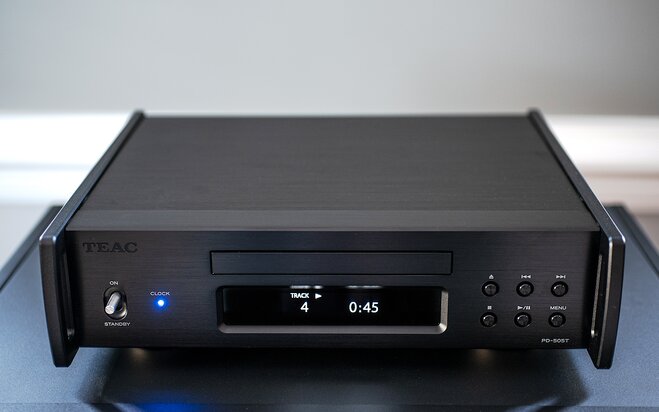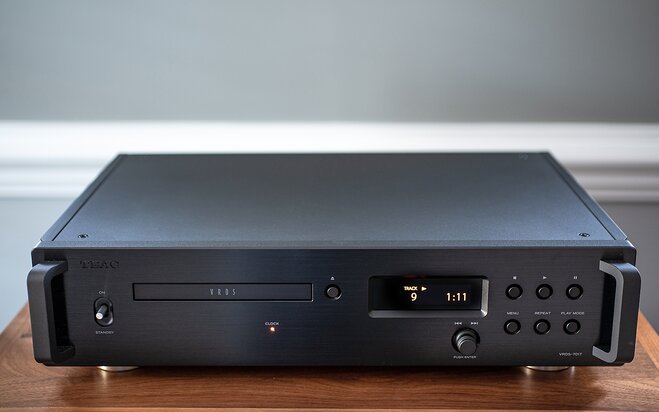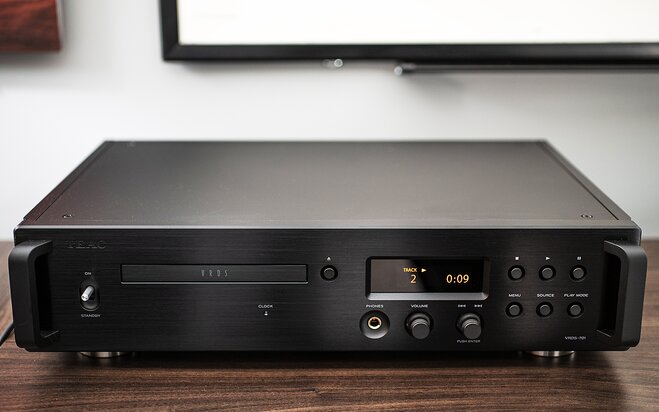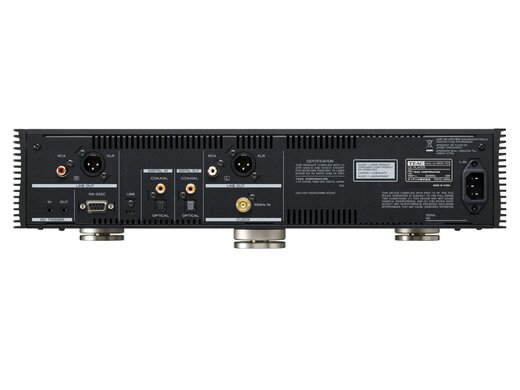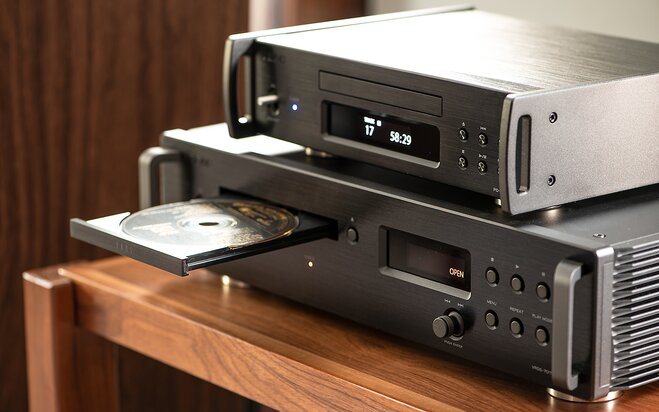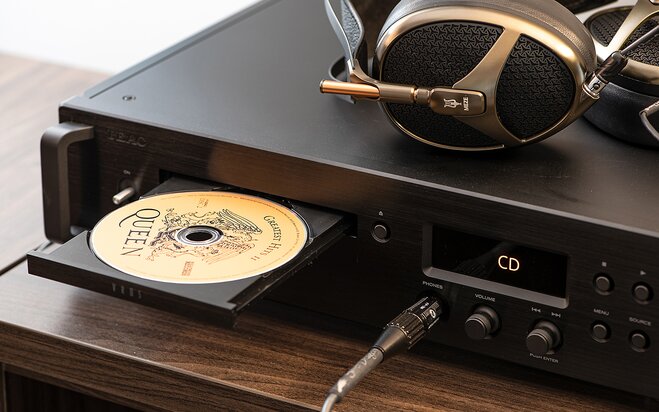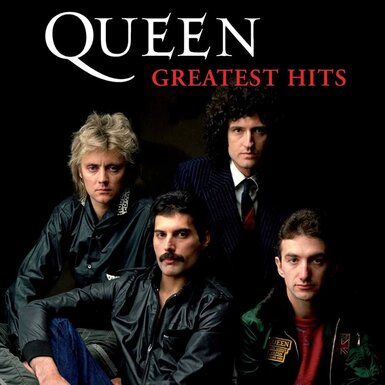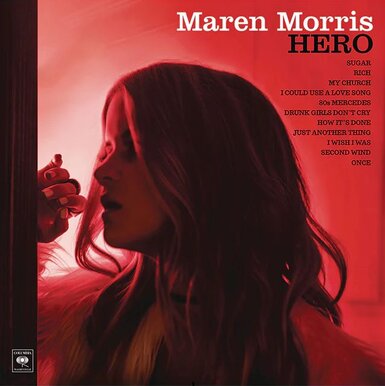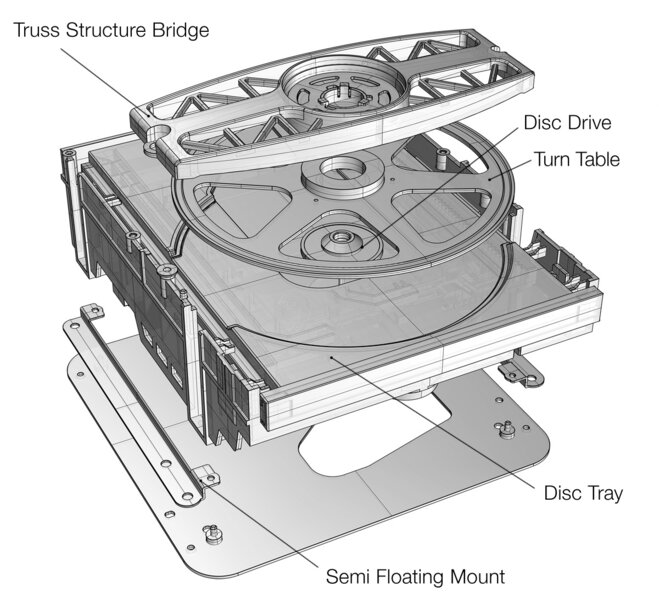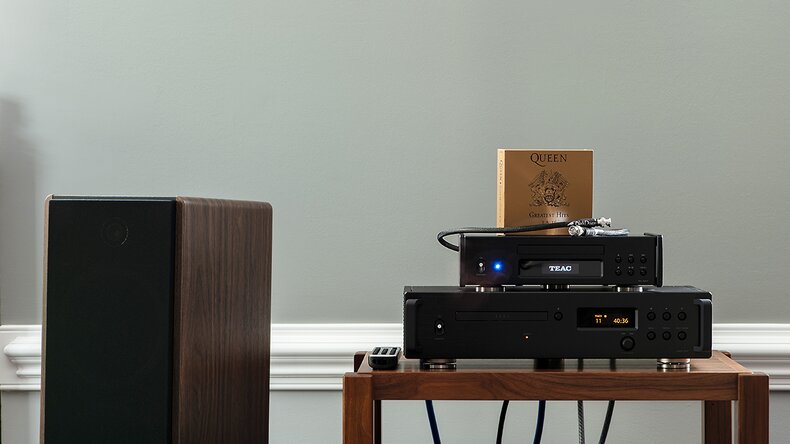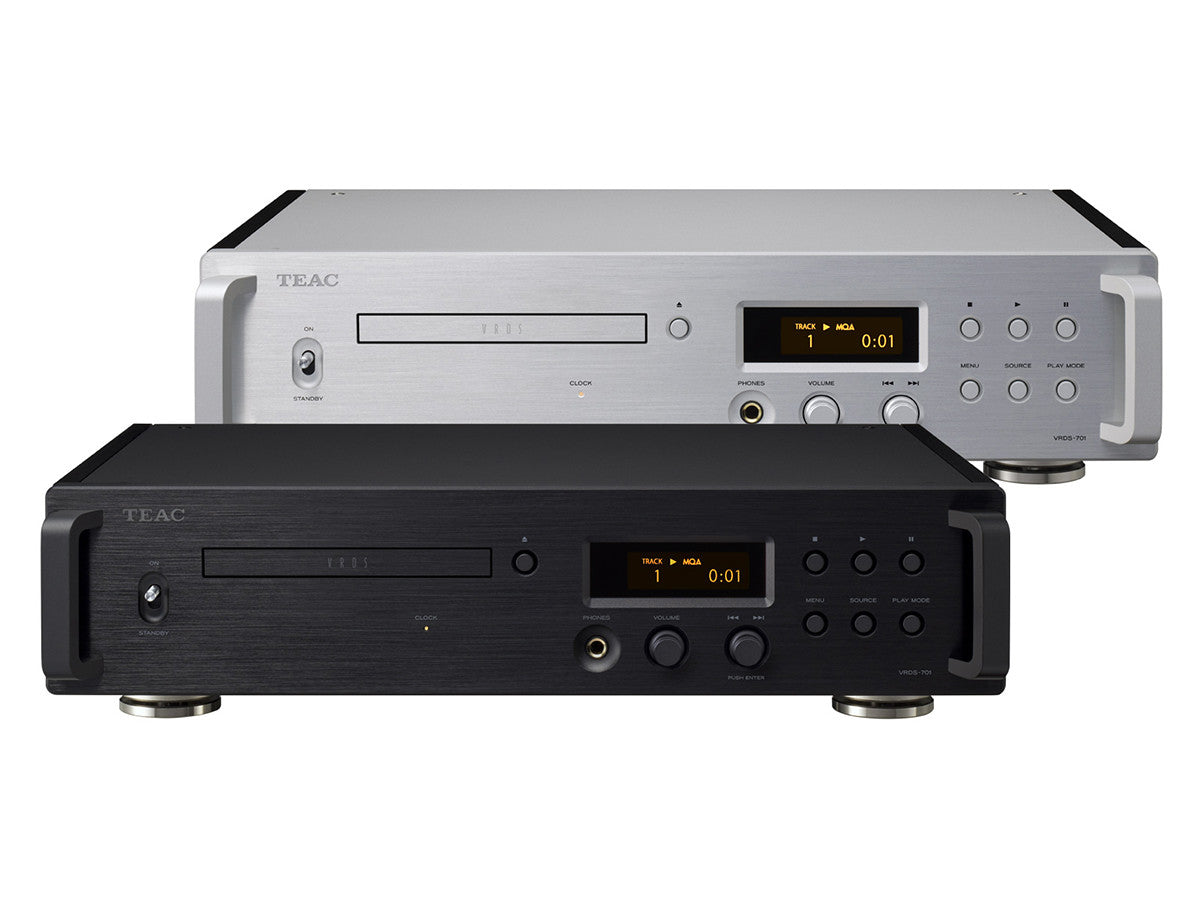
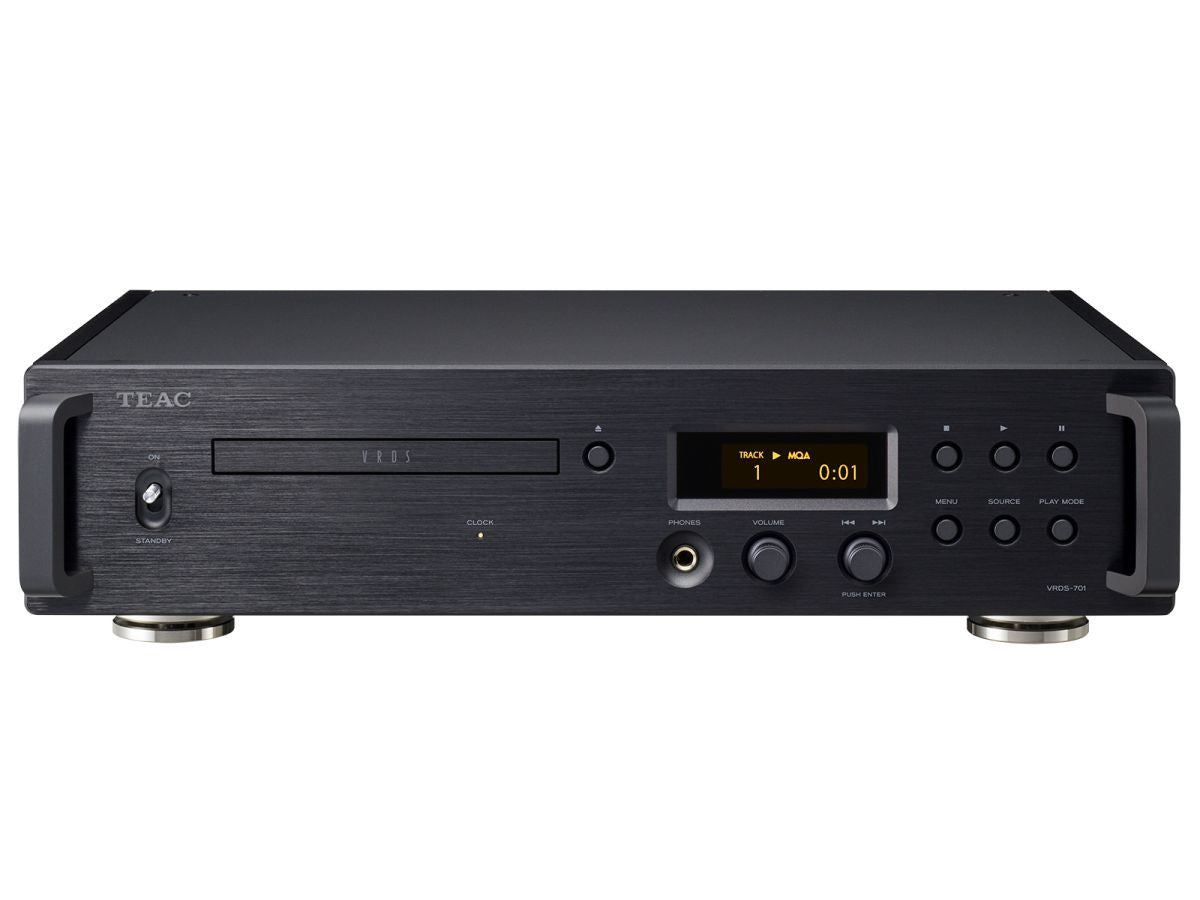
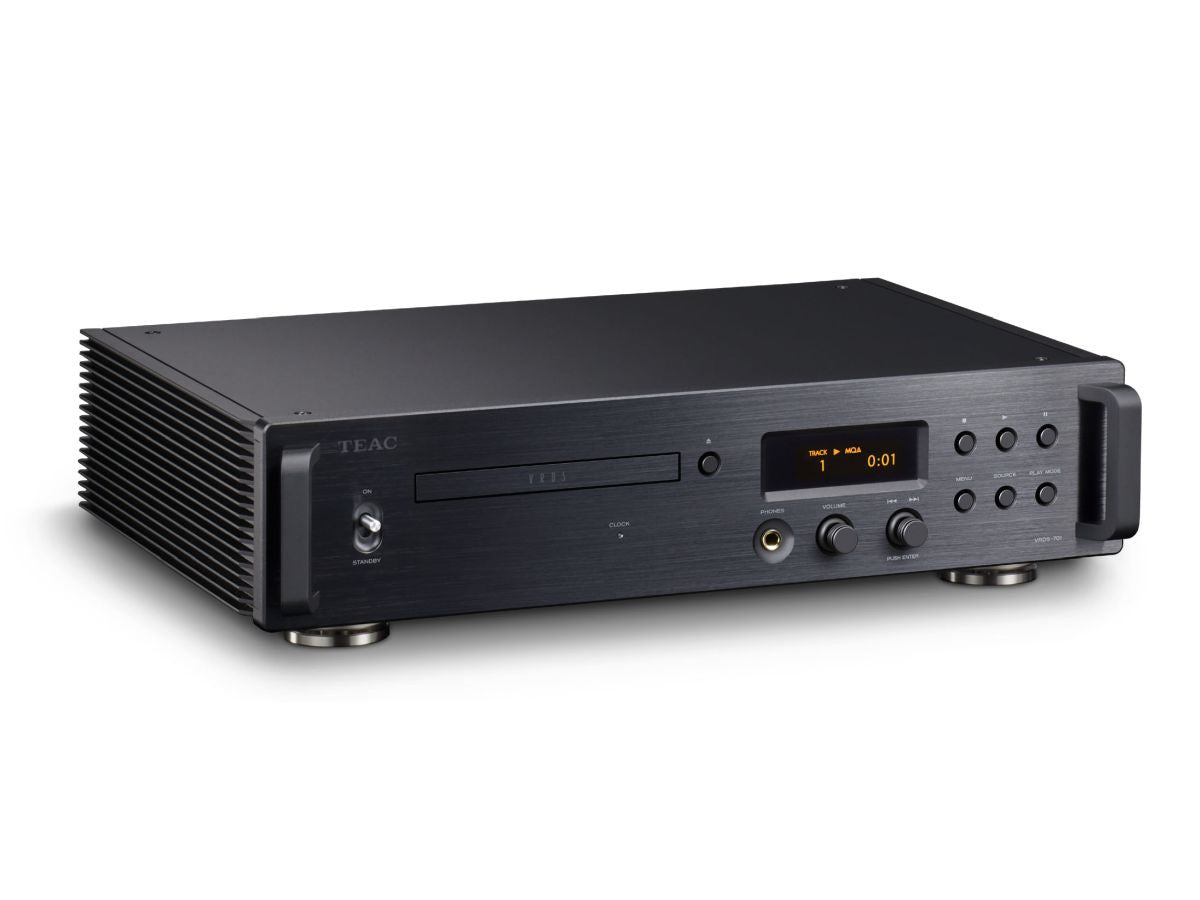
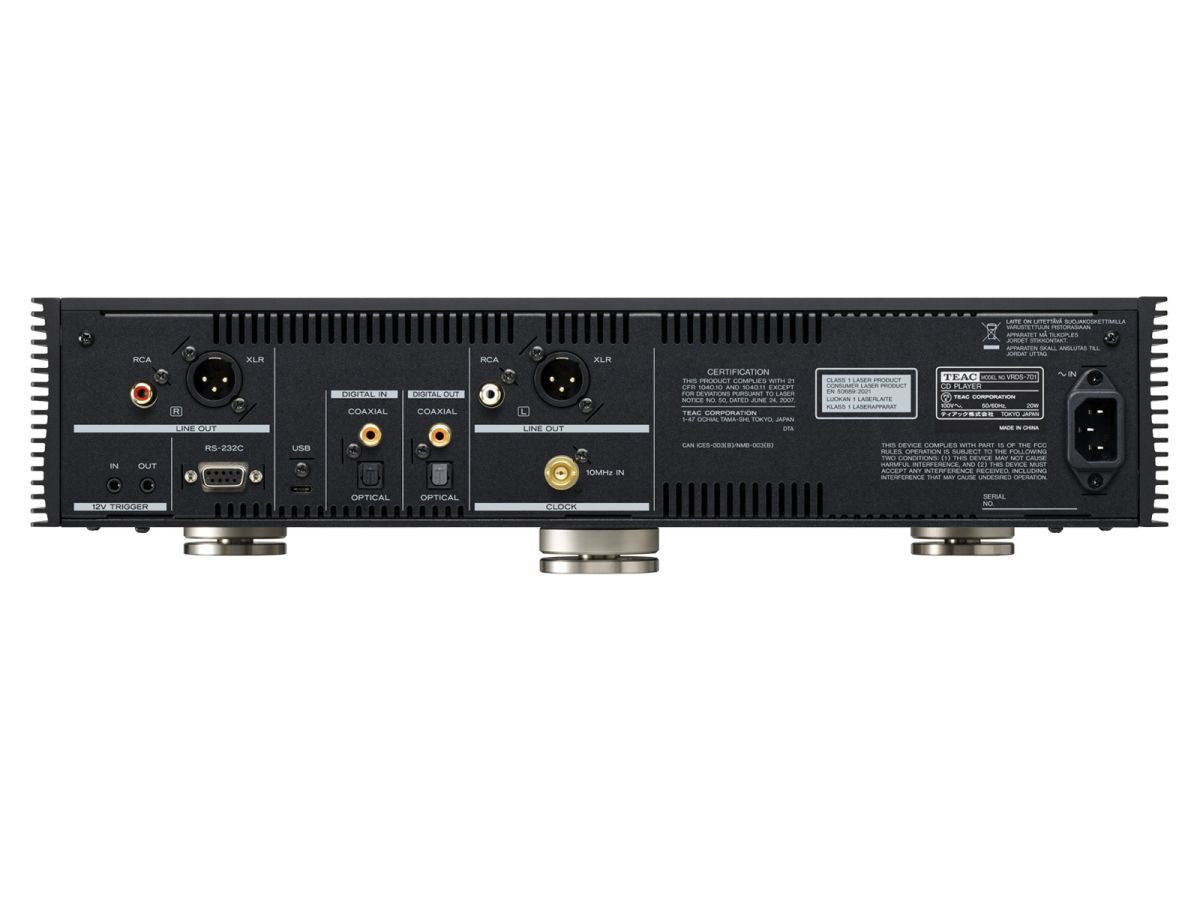
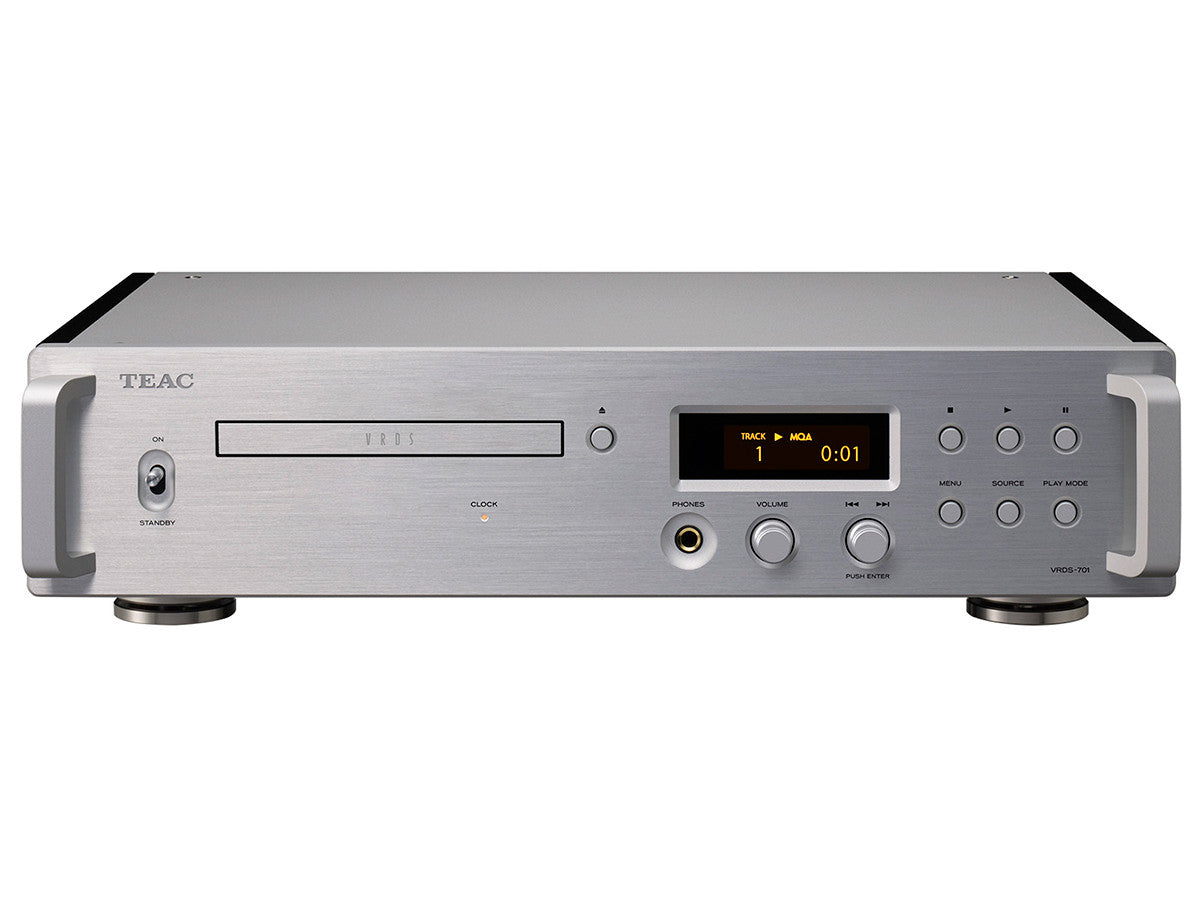
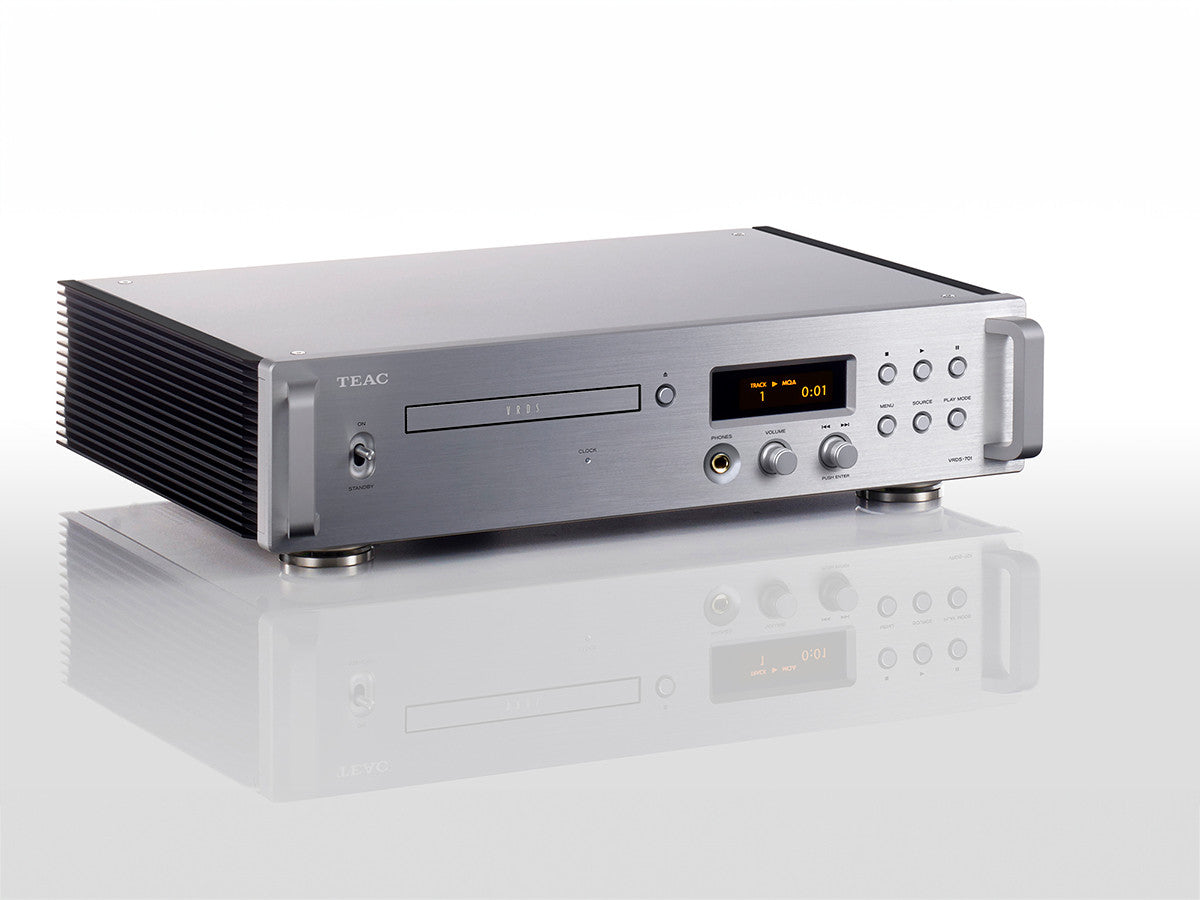
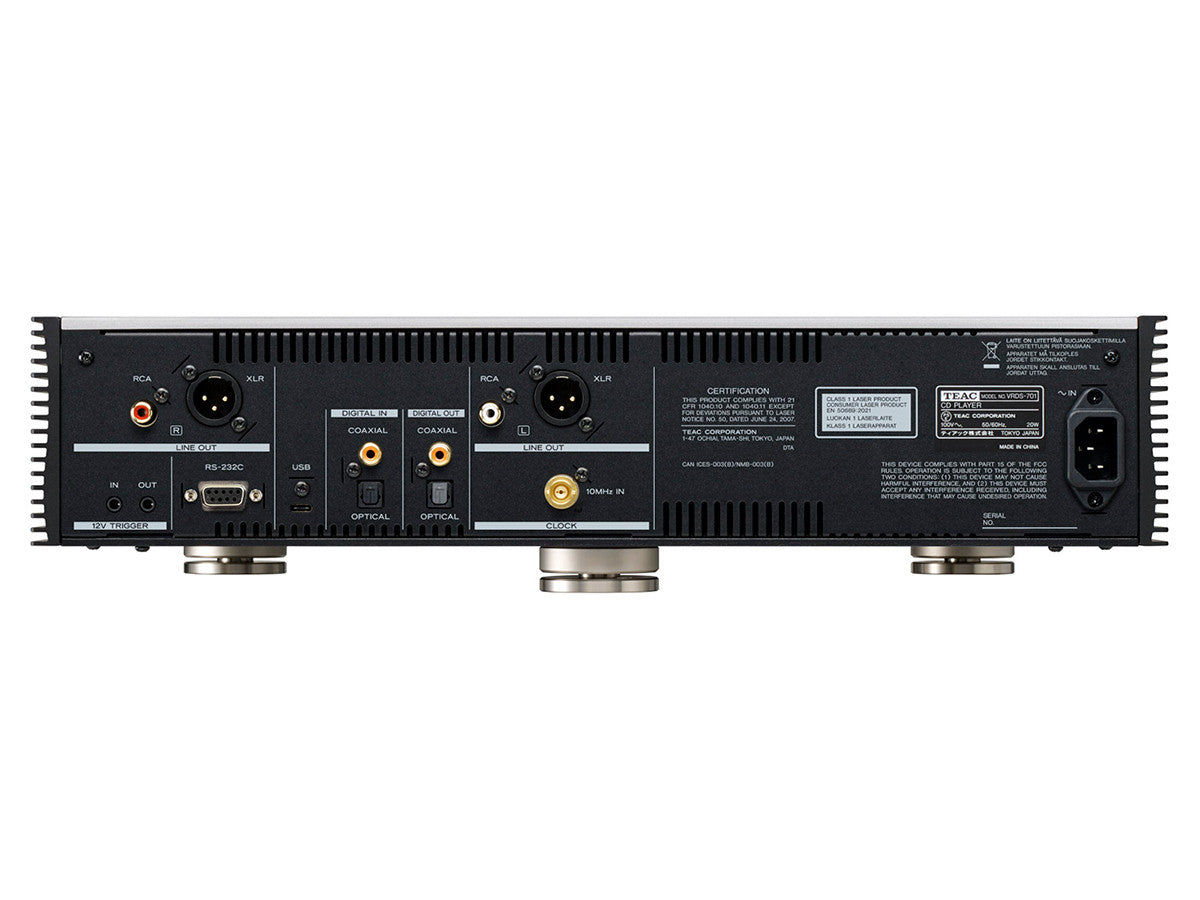
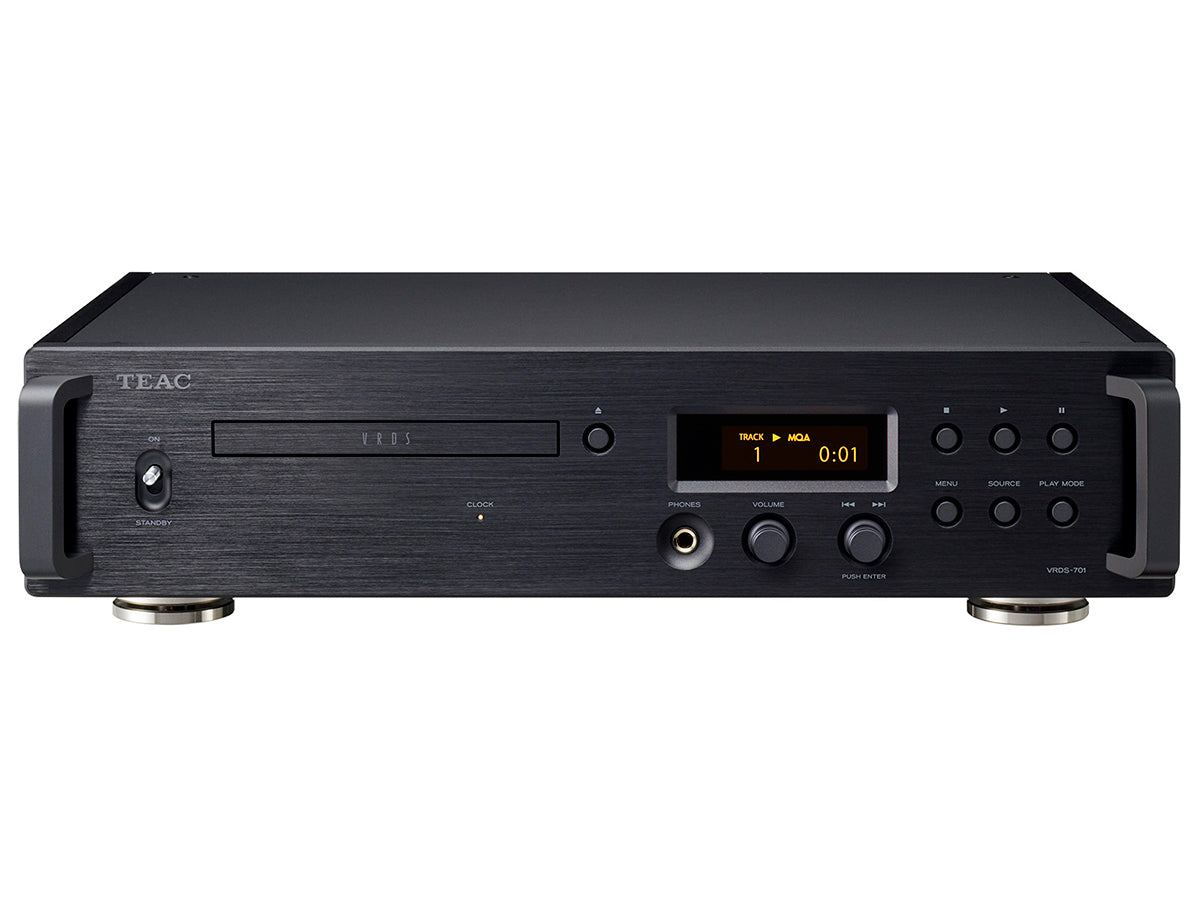
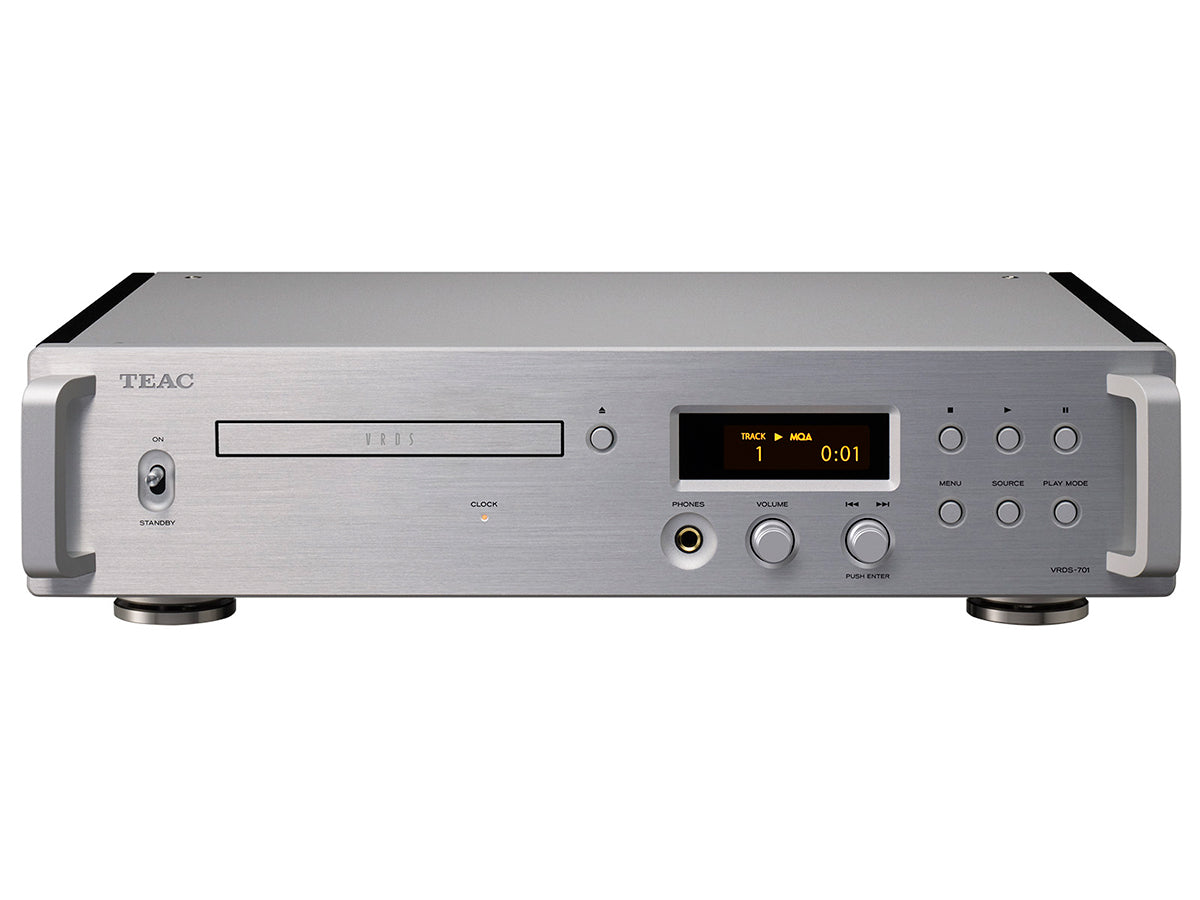
TEAC Audio
VRDS-701 CD Player, USB DAC
$3,599.99 USD
Features
An original TEAC-designed discrete DAC is used for the digital audio converter, which is key to determining audio quality
Fully-balanced dual mono circuit structure realizes outstanding channel separation
Direct connection with a power amplifier is possible thanks to volume control that uses a TEAC-QVCS analog preamp circuit
Along with MQA CD playback, full MQA decoding of digital input is possible
As a USB DAC, 22.5MHz DSD and 384kHz/32-bit PCM data can be played back
2×, 4× and 8× upconversion using RDOT-NEO
10MHz external clock input
Analog, digital input/output and CD drive circuits each have dedicated toroidal core transformers
Original TEAC-HCLD2 enhanced-current output buffer circuitHeadphone amp has a high output circuit with low distortion, high signal-to-noise ratio and a high 2000V/μs through rate
Video
What's in the Box?
Warranty
Features At a Glance
- A newly developed VRDS mechanism is used for the CD drive
- An original TEAC-designed discrete DAC is used for the digital audio converter, which is key to determining audio quality
- Fully-balanced dual mono circuit structure realizes outstanding channel separation
- Direct connection with a power amplifier is possible thanks to volume control that uses a TEAC-QVCS analog preamp circuit
- Along with MQA CD playback, full MQA decoding of digital input is possible
- As a USB DAC, 22.5MHz DSD and 384kHz/32-bit PCM data can be played back
- 2×, 4× and 8× upconversion using RDOT-NEO
- 10MHz external clock input
- Analog, digital input/output and CD drive circuits each have dedicated toroidal core transformers
- Original TEAC-HCLD2 enhanced-current output buffer circuitHeadphone amp has a high output circuit with low distortion, high signal-to-noise ratio and a high 2000V/μs through rate
Commemorating the 70th anniversary of TEAC's founding, this model brings innovation and epitomizes TEAC's strengths, including a newly-developed VRDS mechanism.
Newly-developed VRDS mechanism
TEAC started with a drive they developed that has a long record of use in broadcast applications, while also adding VRDS technologies, which are part of our TEAC legacy.
Including: Vibration-Free Rigid Disc-Clamping System ( VRDS), a Bridge section supporting the VRDS, and a Semi-floating mounting
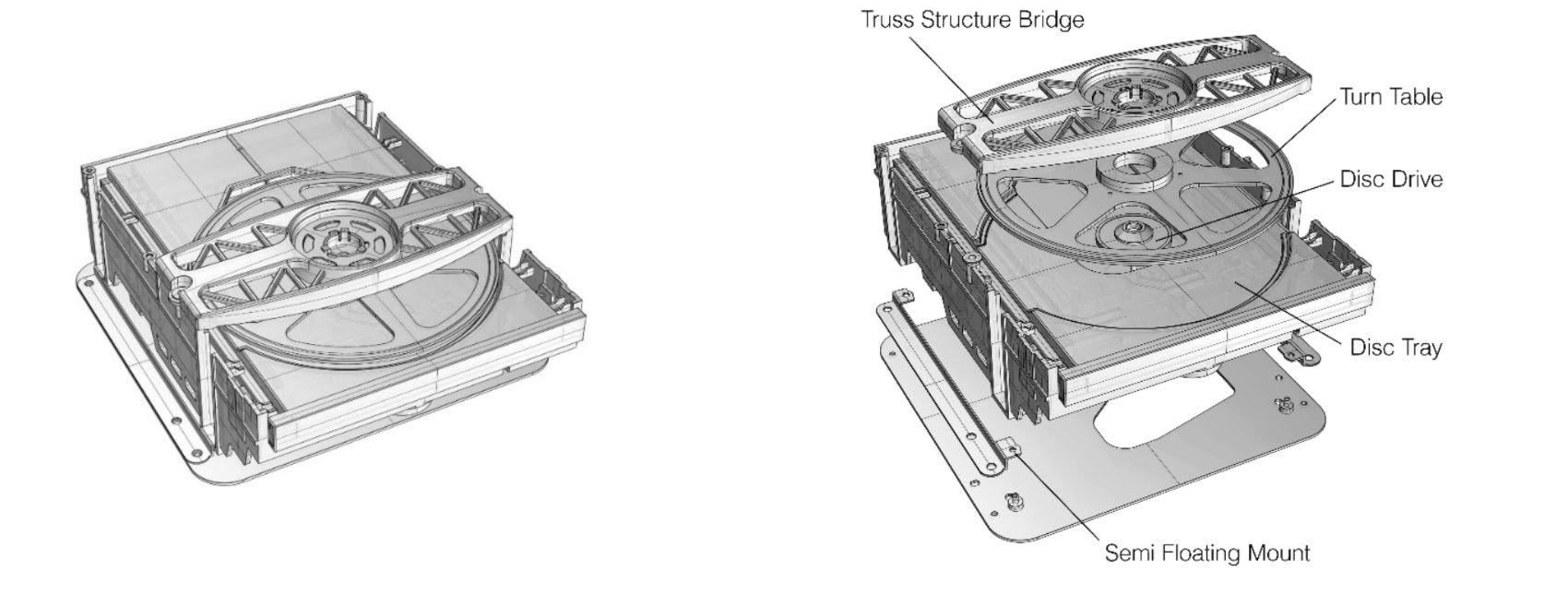
TEAC ɅƩdelta-sigma discrete DAC
Instead of an ordinary DAC IC, the DAC section, which is critical for determining the sound, is a TEAC ΔΣ (Delta Sigma) discrete DAC that consists of a discrete circuit structure that incorporates our unique algorithms using FPGA. DSD signals are left as is, while PCM signals are transmitted after passing through the ΔΣ modulator and converation to either 1-bit or multi-bit signals; according to the end users choosing. The sound field that is wide and perfectly clear can be realized only because of this discrete design. The result is that TEAC can say they have achieved the sound sought by TEAC. With a TEAC ΔΣ discrete DAC, playback of 22.5MHz DSD and 384kHz/32-bit PCM data is possible.
Dual mono structure
Using the independent left and right toroidal core transformers, TEAC has employed an indulgent dual mono structure for the circuitry from the power supply circuit through the D/A converter section to the analog output stage.
The dual mono structure has two sets of circuitry that provide complete mono paths for each channel. This prevents interference between the left and right signals and realizes rich musical expression that emphasizes the perception of the sound space and three-dimensionality.
Fully-balanced transmission at every stage
Fully-balanced transmission of the left and right analog output signals from D/A conversion to the final output stage contributes greatly to improving the signal-to-noise ratio and extending the dynamic range. The sense of air that high-resolution audio sources have can be transmitted without loss in an even purer state.
Direct connection is possible with power amplifiers that use TEAC-QVCS
TEAC-QVCSThis player can be directly connected to a power amp and used without a preamp due to the inclusion of TEAC-QVCS, which is an analog variable gain amp type attenuator with a fully-balanced structure.
TEAC-QVCS (Quad Volume Control System) is a variable gain amp type volume control comprised of four discrete left, right, positive and negative (L+, L–, R+ and R–) circuits. This theoretically prevents "gang errors" (level discrepancies between left and right channels at low volumes) and enables extremely precise analog volume adjustment in 0.5dB increments from–95 dB to +24 dB.
The two sets of analog outputs (balanced/unbalanced) can be set to fixed or variable output.

Inclusion of an MQA full decoder enables MQA CD playback
MQA (Master Quality Authenticated) is a high-quality audio codec for playing music with the uncompromised quality of the master captured in the studio. The VRDS-701 includes an MQA decoder that controls waveforms converted from digital to analog at a precision as high as 5ms in order to achieve analog waveforms that are more faithful to the original sound sources. By greatly reducing “temporal blur,” which tends to occur at points when sound pressure differences are extreme, including when sounds begin suddenly, playback sound that is close to the original source in terms of human hearing can be achieved. The inclusion of an MQA full-decoder not only enables enjoyment of MQA CDs, it also makes decoding of MQA data from the digital inputs possible, allowing playback of MQA files from a computer when used as a USB DAC.

As a USB DAC, 22.5MHz DSD andr 384kHz/32-bit PCM data can be played back
A USB Type-C port is available for digital input. The VRDS-701 is much more than a CD player. Connected to a computer with USB, it can be used as a USB DAC, enabling enjoyment of the computer audio world with high-resolution audio sources.
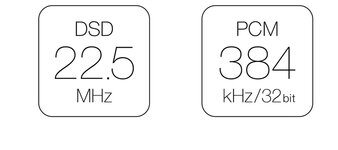
2×, 4× and 8× upconversion using RDOT-NEO
RDOT-NEO (Refined Digital Output Technology NEO), which smoothly augments digital audio signals, provides a function to upconvert the sampling frequency of PCM digital signals 2×, 4× or 8× (up to 384 kHz). RDOT, which applies an analogous interpolation method using fluency logic, is a technology that was developed to enable the playback of the frequencies higher than 20 kHz that are lost by the 44.1kHz/16-bit CD format. Based on the information read from the CD, analogous data is generated between the waveform samples. As a result, data above 20 kHz is also generated
10MHz external clock input
The 10MHz clock input allows synchronization with an external clock. In addition to improving audio quality during playback with the VRDS-701, this also enables synchronization of the entire system with a clock generator.
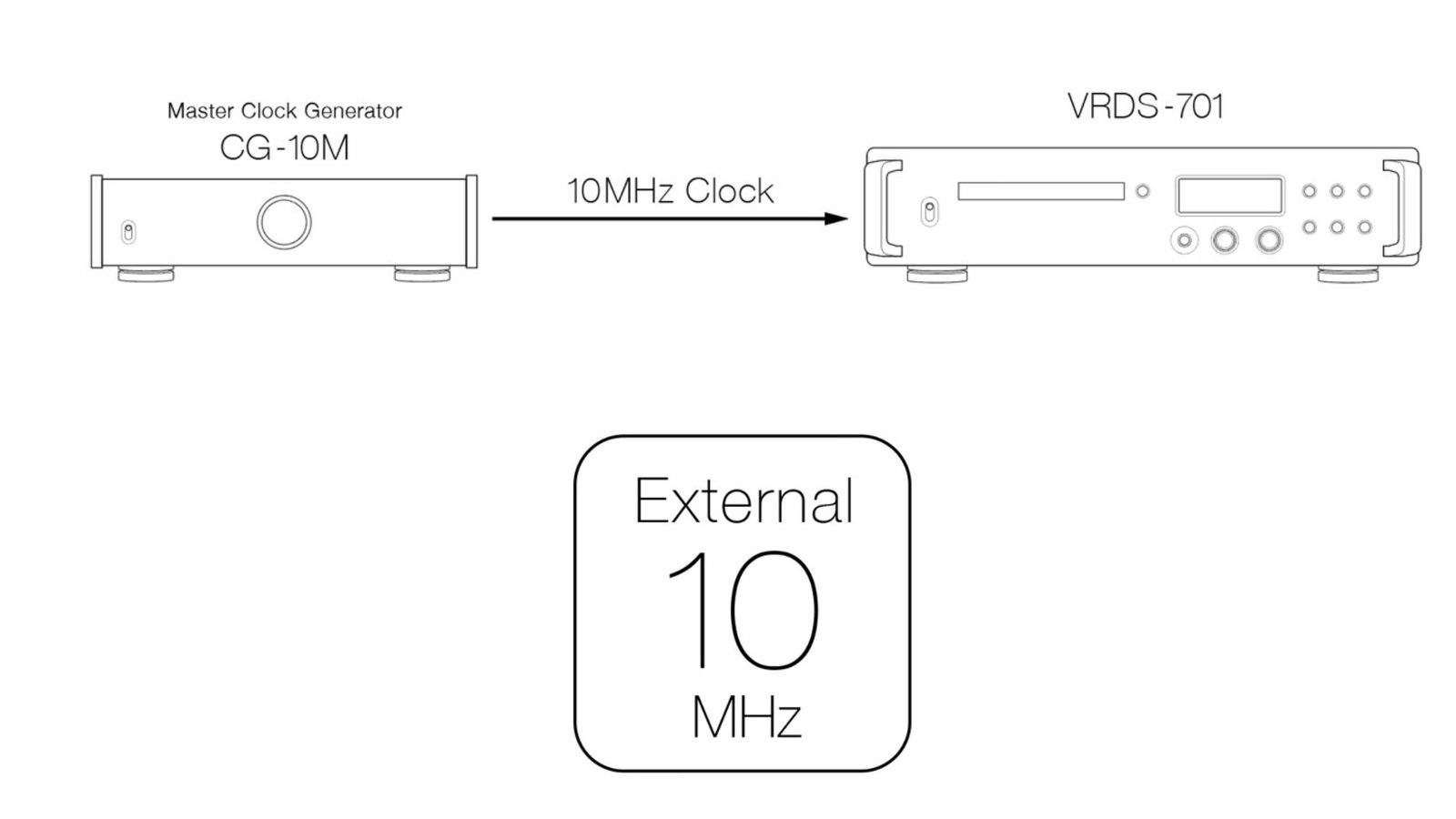
TEAC-HCLD2 enhanced-current output buffer amp circuit
For the analog output circuit, the TEAC-HCLD 2 circuit is an enhanced-current output buffer amp that increases crucial current transmission capability. This model uses diamond buffer amps with high current output capacity as line drivers. By using a positive-negative two-circuit structure for each channel, drive can be differential with balanced output and parallel with unbalanced output. Transmitting audio signals without degrading their dynamism becomes possible with increased current supply capacity.
Headphone amp
The headphone amp has a dedicated driver that uses a high-output circuit with low distortion, high signal-to-noise ratio and a high 2000V/μs through rate, equivalent to a current transmission enhancing output line driver. This will maximize the potential of your headphones.
High-precision dual clock for 44.1kHz and 48kHz multiples with low phase noise
This player has low-phase-noise type high-precision crystal oscillators. Along with 44.1kHz for CD playback, it supports a 48kHz clock, which is necessary for playing files from a computer when used as a USB DAC.


Bulk Pet USB communication technology enables stable data transmission
When sending vast quantities of digital data for high-resolution audio sources through USB cables, large discrepancies can occur in the processing loads of both the transmitting computer and the receiving USB DAC. This creates the possibility of the sound breaking up and other problems. Using Bulk Pet USB transmission technology, however, achieves constant transmission at a fixed data volume, enabling steady data transmission by smoothing the loads for processing on both ends. Since the audio quality can be altered by changing the load on the computer, four preset transmission modes can be chosen according to the desired audio quality.
TEAC HR Audio Player provided free
High-resolution audio sources, up to 22.5MHz DSD or 384kHz/32-bit PCM, can be easily played from Windows and Macintosh computers using this free dedicated software. Digital audio data can be transmitted with certainty under the best conditions by simply starting the software and selecting the VRDS-701 that is connected using a USB cable.
Since the software is designed for use with this product, making USB audio settings is trouble-free.
| Parameter | Specification |
|---|---|
| Physical Specifications | |
| Overall Dimensions | 444 (W) × 111 (H) × 333 (D) mm (including protrusions) |
| Weight | 11.1kg (24.5 LBS) |
| Operating Temperature | +5℃ to +35℃ |
| Operating Humidity | 5% to 85% (no condensation) |
| Storage Temperature Range | −20℃ to +55℃ |
| CD Section Specifications | |
| Supported Media | Audio CD, CD (CD-R/CD-RW) * 8cm CDs not supported |
| Frequency Response | 5Hz to 80kHz (+1dB, –6dB) |
| S/N Ratio | 108dB (A-weight, 1kHz) |
| Total Harmonic Distortion | 0.002% (1kHz, LPF: 20Hz to 20kHz) |
| Digital Input Specifications - USB | |
| USB Connector | USB Type-C × 1 (USB2.0 or more) |
| USB Supported Formats | PCM: 16/24/32bit, 44.1k/48k/88.2k/96k/176.4k/192k/352.8k/384kHz DSD: 2.8M/5.6M/11.2M/22.5MHz |
| Digital Input Specifications - Coaxial/Optical | |
| Coaxial Input | Connector: RCA × 1 Input level: 0.5Vp-p, Input impedance: 75Ω Supported formats: PCM 16/24bit, 32k/44.1k/48k/88.2k/96k/176.4k/192kHz; DSD 2.8MHz |
| Optical Input | Connector: TOS (JEITA RC5720C) × 1 Input level: –24.0 to –14.5dBm peak Supported formats: PCM 16/24bit, 32k/44.1k/48k/88.2k/96k/176.4k/192kHz; DSD 2.8MHz |
| Digital Output Specifications | |
| Coaxial Output | Connector: RCA × 1 Output level: 0.5Vp-p, Output impedance: 75Ω |
| Optical Output | Connector: TOS (JEITA RC5720C) × 1 |
| Analog Audio Output Specifications - Balanced | |
| Balanced Connectors | XLR × 1 pair |
| Balanced Maximum Output Level | 2.0Vrms (1kHz, Full scale, 10kΩ loaded, FIXED 0dB) 4.0Vrms (1kHz, Full scale, 10kΩ loaded, FIXED +6dB) 12Vrms (1kHz, Full scale, 10kΩ loaded, VARIABLE) |
| Balanced Output Impedance | 220Ω |
| Analog Audio Output Specifications - Unbalanced | |
| Unbalanced Connectors | RCA × 1 pair |
| Unbalanced Maximum Output Level | 2.0Vrms (1kHz, Full scale, 10kΩ loaded, FIXED 0dB) 4.0Vrms (1kHz, Full scale, 10kΩ loaded, FIXED +6dB) 6Vrms (1kHz, Full scale, 10kΩ loaded, VARIABLE) |
| Unbalanced Output Impedance | 180Ω |
| Headphone Output Specifications | |
| Headphone Connector | ¼″ (6.3mm) Stereo jack × 1 |
| Maximum Output | 500mW + 500mW (into 32Ω) |
| Clock & External Control Specifications | |
| Clock Sync Input | Connector: BNC × 1 Input frequency: 10MHz, Input impedance: 50Ω Input level: Rectangle wave (TTL level), Sine wave (0.5 to 1.0Vrms) |
| Trigger In (12V TRIGGER IN) | Connector: 3.5mm Mono mini jack × 1 Input level: 12V |
| Trigger Out (12V TRIGGER THRU) | Connector: 3.5mm Mono mini jack × 1 Output level: 12V, 1mA Maximum current supply: 100mA |
| Power Specifications | |
| Power Supply | AC120V, 60Hz AC220-240V, 50/60Hz |
| Power Consumption | 20W |
| Standby Power | 0.4W |
| Included Accessories | |
| Package Contents | AC cord, Remote control (RC-1338), AAA batteries × 2, Foot pads × 3, Owner's manual |






